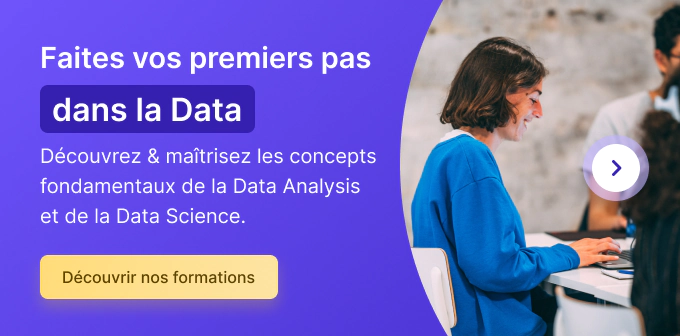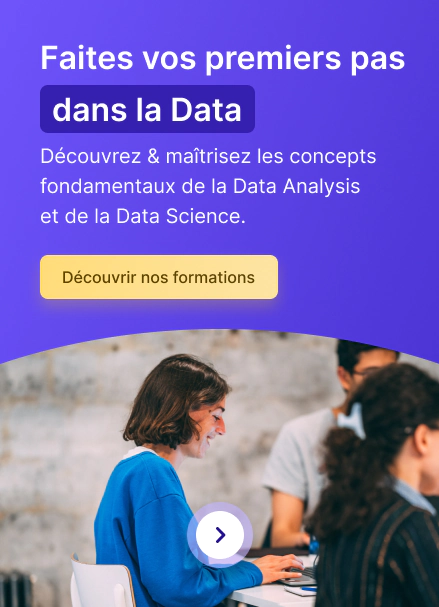Apprendre les bases du langage Python

Sélectionnez un chapitre
Python est un langage de haut niveau utilisé dans différents types de projets. Adapté à la plupart des plateformes informatiques, Python est considéré par beaucoup de professionnels comme un excellent outil pour faire ses premiers pas dans la programmation informatique. Voici les concepts de bases nécessaires pour écrire un code en Python. Ce sont les premières choses que vous apprendriez dans nos formations à Python.
Mon 1er programme
Habituellement, le programme « Hello World ! » est utilisé en exemple pour présenter aux étudiants la syntaxe d'un langage de programmation comme Python. C'est une programmation de base, qui affiche juste l'expression « Hello World ! » à l'écran, avant de prendre fin. Ce premier programme en Python est créé avec une unique ligne de code : il suffit de sélectionner print (« Hello World ! »). En effet, le langage Python intègre une fonction prédéfinie print qui permet d'afficher les données, le texte ou les caractères qui lui sont fournis.
Fonctions de base et opérateurs
En programmation, les fonctions représentent une suite d'instructions réutilisables par le développeur pour ne pas avoir à écrire plusieurs fois le même code dans son programme. La fonction « print » permet ainsi d'afficher une donnée, quel que soit le type. Avec la fonction input, on va être en mesure de lire une entrée. La fonction « len » renvoie quant à elle à la chaîne Long qui contient le nombre de caractères requis pour une chaîne ou le nombre d'octets nécessaire pour le stockage d'une variable. Cette dernière fonction est utile dans le calcul de la taille des données composées. On peut citer aussi la fonction « str » qui sert à convertir les données en chaîne, peu importe le type.
En ce qui concerne les opérateurs, il s'agit de signes ou de symboles qui vont permettre l'exécution d'une opération. Le langage de programmation Python dispose de plusieurs opérateurs. Les opérateurs arithmétiques servent à réaliser des calculs mathématiques (additions, soustraction, multiplication, etc.) entre les variables contenant des valeurs numériques.
Avec les opérateurs de chaînes, on va pouvoir manipuler les données de type str (les chaînes de caractères) et par la même occasion les variables qui contiennent ce type de données. Le langage Python propose deux opérateurs de chaînes :
- l'opérateur de concaténation pour relier bout à bout deux chaînes de caractères afin d'avoir une troisième et nouvelle chaîne,
- l'opérateur de répétition pour reprendre une chaîne un certain nombre de fois.
Sur Python, on distingue aussi l'opérateur d'affection simple, le symbole « = », utilisé pour affecter ou assigner une valeur à une variable. Il existe aussi des opérateurs d'affectation composés qui servent à réaliser deux opérations à la suite notamment une opération de calcul ainsi qu'une opération d'affectation. D'autres opérateurs sont proposés par le langage comme les opérateurs de comparaison, d'identité, logiques, binaires ou encore d'appartenance.

Les variables
Les variables en Python peuvent être considérées comme des emplacements de mémoire servant au stockage d'une valeur à qui un nom est attribué pour une meilleure identification. Pour accéder au contenu d'une variable (en utilisant la fonction « print » par exemple), il faut d'abord que la variable soit initialisée en lui affectant une valeur. Lorsqu'on essaie d'utiliser une variable non initialisée, le programme s'arrête et l'interpréteur Python produit ce qu'on appelle une erreur d'exécution. Avec les variables, on a la possibilité de stocker différents types de valeurs, qu'il s'agisse de nombres, de chaînes de caractères, de booléens, etc.
Fonctions de test
Faire un test permet au développeur d'éviter les erreurs dans le code qu'il est en train d'écrire. Les fonctions de test permettent ainsi l'exécution de diverses instructions en tenant compte d'une condition logique. En effet, pour être certain de son code, il faut le tester sur chaque cas de figure d'utilisation du programme. Cela étant difficile à réaliser avec les programmes complexes, on recommande de découper le code en fonctions de tailles raisonnables qui seront testées de façon indépendante. Les tests effectués pour chacune des fonctions sont des tests unitaires.
Avec le langage Python, la condition « if…elif…else » (pour « si, sinon si, sinon ») représente une structure conditionnelle complète qui va permettre de faire plusieurs tests en prenant en compte le nombre de cas souhaité.
Les types de données
La plupart du temps, un programme informatique sera utilisé pour manipuler des données. Avec le langage Python, on a plusieurs types de données prédéfinies dont les plus populaires sont les nombres et les chaînes de caractères.
Le langage Python distingue trois types de données numériques :
- le type entier (int) représentant les nombres entiers, peu importe leur taille,
- le type flottant (float) pour les nombres comportant une partie décimale,
- le type complexe (complex) pour les nombres complexes avec une partie imaginaire nommée J.
Sous Python, la chaîne de caractères est représentée par le type str correspondant à une suite de caractères délimitée par des apostrophes ou des guillemets. On utilise aussi le type bool pour les booléens, des types de données pouvant prendre les valeurs True ou False. Les données de type liste (list) représentent une collection d'éléments (de nombres, de chaînes de caractères…) séparés par des virgules, le tout étant inscrit à l'intérieur de crochets.
Les boucles
En programmation, les boucles vont faciliter la répétition d'une suite d'instructions selon certaines conditions. On a par exemple les boucles « while » et les boucles « for ».
Avec la boucle « while », on exécute une série d'instructions qui obéissent à une condition donnée. En général cela se passe en trois étapes : l'initialisation de la variable d'itération (i), le test de la variable et la mise à jour de la variable.
Utilisée aussi pour répéter un bloc d'instructions, la boucle « for » sert en général à itérer sur une séquence prédéfinie de valeurs. Les séquences pouvant être de différents types.

Les fonctions
En dehors des fonctions prédéfinies de Python, le langage de programmation donne aussi la possibilité à l'utilisateur de définir ses propres fonctions qui seront disponibles et utilisables seulement dans son espace. On pourra écrire ses propres fonctions Python pour des programmes qui utilisent de façon répétée la même série d'instructions. Cela permet de ne pas avoir à réécrire ces instructions à chaque fois. Les fonctions sont aussi très utiles pour simplifier son code surtout lorsqu'il doit être partagé avec d'autres développeurs.
C'est le mot clef « def » qui permet d'introduire la définition d'une nouvelle fonction en Python. Dans le code, le mot clef s'accompagne du nom de la fonction, de parenthèses dans lesquelles sera fournie une liste de paramètres, et deux-points « : » pour terminer la ligne. Le nom de la fonction doit obéir aux règles générales concernant les noms en langage Python notamment : commencer par une lettre ou un underscore et être constitué uniquement de caractères alphanumériques classiques.
Dictionnaires
Il arrive que les développeurs doivent représenter des données plus complexes que de simples nombres, chaînes de caractères ou listes. Dans ce cas, le dictionnaire est la structure de données à utiliser avec le langage Python. Il permet l'enregistrement des données dans des paires clés-valeurs. Les dictionnaires sont définis par des accolades au début et à la fin. La paire clé-valeur contient un deux-points entre la clé et la valeur, puis une virgule à la fin. Chaque dictionnaire est composé de clés uniques.
Ces différentes notions font partie des bases de la programmation avec le langage Python. La manipulation des variables, des types de données et des fonctions doit être comprise et maitrisée par tous ceux qui désirent faire carrière dans la Data science ou encore en développement web. Avec la formation Jedha, les apprenants peuvent faire leur premier pas dans ces secteurs porteurs, en optant pour un programme de cours qui s'adapte à leur rythme d'apprentissage.
Articles recommandés
Python
Qu'est-ce que la programmation orientée objet | Jedha
En tant que langage de programmation orienté object Python apporte de grands avantages de la modularité, l’abstraction, la productivité et ré-utilisabilité, la sûreté. Découvrez ce qu'est un langage orienté objet.
Python
Mon premier programme Python | Jedha
Python est un langage de programmation, il convient aux débutants comme aux experts. On vous explique comment construire votre premier code
Python
Les variables en Python | Jedha
Pas de programmation sans variables, à quoi servent-elles ? Quels types de variables existent et comment les utiliser sous Python.
Python
Les boucles en Python | Jedha
Très utilisées en programmation les boucles permettent d'exécuter plusieurs fois le même code avec des variables différentes en paramètres. Découvrez comment les instancier avec Python.




